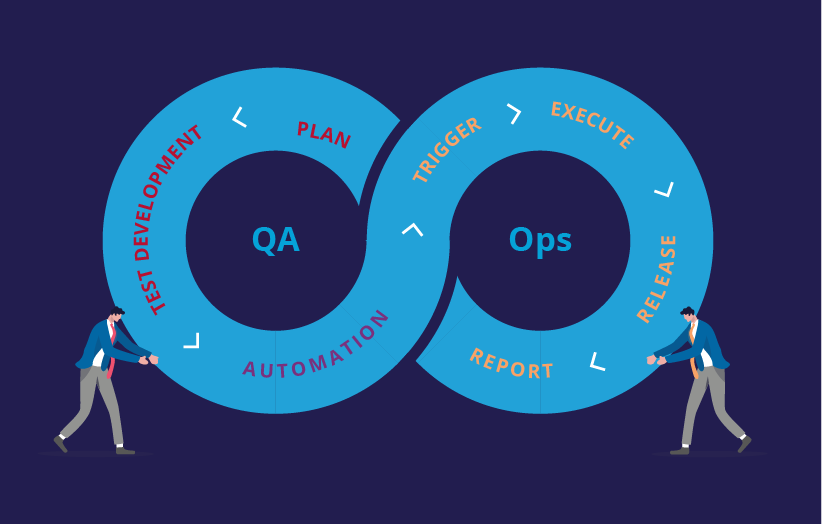In today’s fast-paced world, traditional handoffs from testers to developers can lead to inefficiencies and compromise product quality, which can have a negative impact on the entire business. However, by fostering collaboration and breaking down barriers, testers and developers can establish a mutually beneficial relationship that enables faster feedback cycles, improves testing efforts, and cultivates a shared sense of responsibility for quality.
This article will delve into our methods and strategies for enhancing collaboration between testers and developers in an agile environment. We will emphasize the importance of early involvement, effective communication, and the use of modern tools and methodologies.
Why does the collaboration cap happen?
Communication challenges between testers and developers arise from differences in terminology, mindsets, and problem-solving approaches. When testers are involved late in the process, there is a lack of shared understanding and difficulty in aligning expectations. Tight deadlines and heavy workloads lead to rushed communication and inadequate information sharing. Insufficient communication channels hinder collaboration and cause delays. Additionally, a lack of collaboration impedes effective communication. Insufficient documentation and feedback can also contribute to misunderstandings and require rework.
However, these challenges can be overcome by improving processes, fostering collaboration, enhancing communication channels, and promoting a culture of shared responsibility.
What are key strategies to improve collaboration?
Rather than following a rigid waterfall-like sequence where testers receive user stories at the end of an iteration, I believe agile teams can greatly benefit from a more integrated approach. By blending the roles and responsibilities of testers and developers, we can unlock the true potential of collaboration. Let’s explore some key strategies to achieve this synergy:
Collaborative Planning: It is essential for testers and developers to engage in open discussions about testing requirements and approaches even before the construction of a user story begins. This early involvement allows testing to inform the construction process, enabling testers to provide advice on scripted tests while leaving room for additional exploratory tests later on. By blending their perspectives, testers and developers can establish a strong foundation for successful collaboration.
Real-Time Feedback: Waiting for formal builds to provide feedback is a thing of the past. In today’s dynamic environment, involving testers in near real-time can provide developers with early feedback on their work, helping them identify ambiguities and make necessary improvements. This iterative feedback loop fosters continuous improvement and ensures that any issues are promptly addressed, leading to higher product quality.
Mutual Understanding: Collaboration thrives on shared knowledge. Developers should actively assist testers in understanding the codebase, while testers should familiarize developers with the test suite and related techniques. This mutual understanding strengthens collaboration and empowers both parties to make informed decisions regarding testing efforts. By working closely together, testers and developers can create a robust framework for successful collaboration.
Effective Communication: Effective communication is the backbone of any collaborative effort. While face-to-face conversations are ideal, remote teams like ours can easily leverage collaboration tools such as Slack or Google Meet to bridge the distance and maintain a strong line of communication. These tools allow for seamless sharing of updates and alignment with project goals. Regular communication helps bridge gaps, ensures everyone is on the same page, and paves the way for effective collaboration.
Effective approaches to consider
To achieve optimal collaboration, it is crucial to adopt effective approaches and methodologies. Here are some approaches that we at Agilno use to enhance collaboration between testers and developers:
Shift Left Testing: Embracing the concept of shift left testing involves developers gaining a deep understanding of the types of tests performed by the Quality Assurance (QA) team. This understanding empowers developers to improve their coding practices, enabling them to detect and fix bugs early in the development process. By proactively ensuring code quality, developers can reduce the reliance on post-development testing, saving valuable time, money, and resources.
Collaboration Tools: Effective communication and coordination between testers and developers can be facilitated through the use of collaboration tools. These tools provide a centralized platform for sharing updates, progress, and feedback, ensuring that all stakeholders are aligned with the end goal. Tools such as Zephyr or X-Ray, which are Jira plug-ins used for test case management, enable real-time discussions, issue tracking, and document sharing. Leveraging such tools allows development and testing teams to work together seamlessly and achieve more efficient release cycles.
Embracing the QAOps Methodology: QAOps is a methodology that emphasizes collaboration between the QA and DevOps teams. It combines Continuous Integration (CI), Continuous Delivery (CD), and Automation Testing to optimize the release process. In a QAOps environment, code changes are regularly committed through a CI/CD pipeline, and automated test scripts are integrated as triggered jobs. This approach provides immediate feedback on code quality and test results, allowing developers to actively participate in testing during the development phase. QAOps nurtures collaboration and shared responsibility among teams for delivering high-quality products.

To streamline web application releases, effective collaboration and efficient testing processes are essential. By implementing shift left testing, utilizing collaboration tools, and embracing the QAOps methodology, organizations can overcome communication challenges and optimize their release cycles.
These strategies empower developers to take ownership of quality, promote seamless communication between teams, and deliver high-quality web applications efficiently. Adopting these practices has significantly improved client satisfaction and driven business success in the digital realm.
How can improving collaboration between developers and testers enhance efficiency on your project?
To summarize, improving collaboration between software developers and testers on your team is a game-changer for project efficiency and success. By prioritizing effective communication, involving testers early, and embracing collaborative approaches, organizations can unlock numerous benefits.
By working closely together, developers and testers can accelerate software delivery, saving valuable time and resources. Early tester involvement ensures that potential issues are promptly identified and addressed, leading to higher product quality. Improved collaboration also results in significant cost savings by catching and resolving issues early, avoiding expensive rework and preventing bugs from reaching production. This optimized resource utilization reduces development costs and enhances project profitability. Promoting a culture of mutual understanding and effective communication between testers and developers bridges gaps, fosters innovation, and ensures a smoother development process. Strategies such as shift left testing, collaboration tools, and the QAOps methodology further strengthen team collaboration and efficiency.
Embracing agility means recognizing that there is no division between developers and testers. It is a collective effort where the entire team works together to deliver a flawless product. So, why wait any longer? Nurture this collaboration to unlock your business’s full potential, achieve growth, and differentiate yourself from the competition. Together, we can revolutionize your organization’s operations and create a culture of collaboration that drives success.



